Australia So Much to See


We travelled over 3,000 kilometres during the two weeks, and although not spectacular scenic country like the north of the state,
it was a time to marvel at those who came so far to such a dry and barren land in search of gold. Tales of so many who came
hoping to make their fortunes from gold, but died young, tales of the Afghan cameleers, without whom there would have been no transport
system, and tales of Aborigines giving water from their scant supplies to a man dying of dehydration and healing the sick with natural
remedies. Today, the region explored by brave pioneers is still thriving with the current mining boom.
2007 We investigate the history of the Coolgardie Kalgoorlie Goldfields including the Holland Track, the John Holland Way, the historicWoodlines and the Golden Quest Discovery Trail. This section completes our journey as we see more of new and old mines.
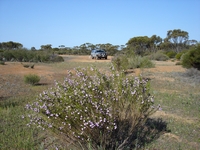
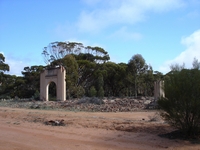
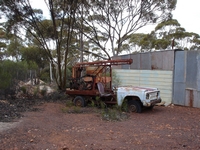
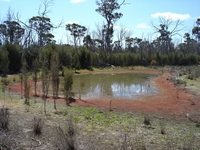
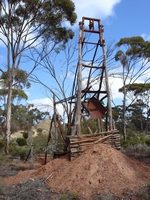
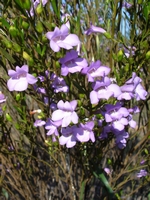
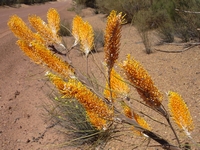
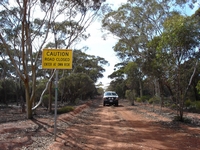
Mines new and old
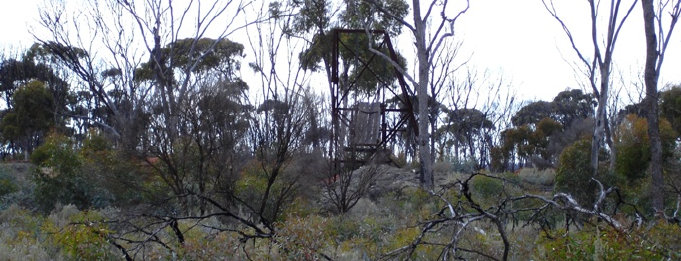
From Coolgardie, we took the Great Eastern Highway west to Yellowdine, choosing from the map a track heading south for our homeward
journey. We discovered that this wide track had signage that it was closed, but it was in good condition and appeared well used.
Driving through woodland and some sand plains on these tracks, we were surprised to see this impressive arch out in the forest, and
identified the area as the little known Mount Palmer gold mine and former settlement.
The Mount Palmer goldmine operated nearby from 1934 to 1944, and a townsite was created which included
an impressive two storey hotel.
Now little remains but the arch and rubble, with the forest having taken over where streets and houses once stood. Since our
visit, a sign with the history of the settlement has been placed by the arch.
The town once included boarding houses,
bakeries, butchers, a school, a medicine shop as well as three billiard saloons. At its peak the population of Mount Palmer was estimated
at 500. In June 1944, after a run of nine years, the Mount Palmer mine ceased operations. By this stage the main shaft was down
to 500 feet (150 metres).
All that remains of "The most pretentious two storey hotel" built in goldfields at the time is the
brick archway. The hotel was famous for its very long bar and two storeys. The bricks were eventually carted to Kalgoorlie and built
into the first chain store in the goldfields. The building is now the Bankwest Bank in Hannan Street, Kalgoorlie.
We joined the Forrestania-Southern Cross Road south of Marvel Loch. We had visited the mining operations at Marvel Loch previously.
This is a very active mining area, and the well maintained gravel roads are wide to accommodate the road trains.
Further south we passed a number of deserted mine shafts in the bush. This one has been constructed from timber, bound together
with fencing wire. A petrol motor to lift the buckets appeared in good order and the flywheel still turned freely.
Not far from this was a mine and camp, with equipment all left there and shed doors swinging open. It looked as though the miner
had left for work one day and not returned. The Toyota Lite Stout dates from the 1960s or 1970s.
Lake Cronin was not easy to find as it is accessed from one of several unsigned tracks. It is documented as having
had a dam built in the middle of it to retain water in dry seasons, however although there was a shallow pool of water at one end
of the pan, it appeared to be merely fed by seepage trickling in through a moist area, with no evidence of a dam.
The nature
reserve at Lake Cronin is a breeding area for the endangered Carnaby’s Cockatoo, and home to the unique Lake Cronin snake which is
rare and endangered.
Sand plains were ablaze with colour and wildflowers big and small. The bright orange candles of Grevillea excelsior dominated.
We concluded our camping by spending the last night amongst wildflowers and birds in an old gravel pit along the Newdegate Lake Grace
Road, after enjoying a very welcome hot shower at Newdegate, something we had discovered newly built at the public convenience block
when we travelled through the town early in the trip.
Copyright (C) 2013 AustraliaSoMuchtoSee.com. All rights reserved